
The eastern copperhead, also known as the copperhead, is a species of venomous snake, a pit viper, endemic to eastern North America; it is a member of the subfamily Crotalinae in the family Viperidae.

Pantherophis obsoletus, also known commonly as the western rat snake, black rat snake, pilot black snake, or simply black snake, is a nonvenomous species of snake in the family Colubridae. The species is native to central North America. There are no subspecies that are recognized as being valid. Its color variations include the Texas rat snake. Along with other snakes of the eastern United States, like the eastern indigo snake and the eastern racer, it is called “black snake”.

Rattlesnakes are venomous snakes that form the genera Crotalus and Sistrurus of the subfamily Crotalinae. All rattlesnakes are vipers. Rattlesnakes are predators that live in a wide array of habitats, hunting small animals such as birds and rodents.
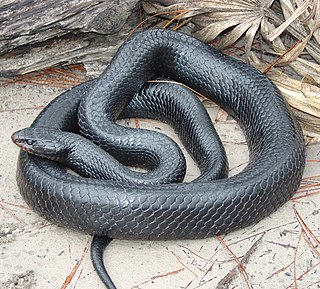
The eastern indigo snake is a species of large, non-venomous snake in the family Colubridae. Native to the southeastern United States, it is the longest native snake species in North America.

Drymarchon is a genus of large nonvenomous colubrid snakes, commonly known as indigo snakes or cribos, found in the Southeastern United States, Central America, and South America.

The desert kingsnake is a species of kingsnake native to Texas, Arizona, and New Mexico, United States. It is not venomous, colored yellow and black. The desert kingsnake's diet consists of rodents, lizards, and smaller snakes, including rattlesnakes. They normally grow 3–4 ft long, but have been known to grow up to 6.8 ft. They are docile creatures when confronted by humans. If they do not try to escape, often they "play dead" by flipping over onto their backs and lying motionless. Some who domesticate kingsnakes, such as ranchers, do so in the hopes that the kingsnakes will feed on other snakes, which might present more of a threat. It was previously considered a subspecies of the common kingsnake. The desert kingsnake belongs to the Colubridae family, which is the largest family of snakes in the world.

Crotalus scutulatus is a highly venomous pit viper species found in the deserts of the southwestern United States and central Mexico. It is perhaps best known for its potent neurotoxic-hemotoxic venom, which is considered the world's most potent rattlesnake venom.
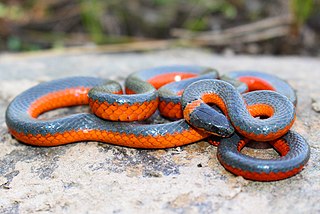
Diadophis punctatus, commonly known as the ring-necked snake or ringneck snake, is a harmless species of colubrid snake found throughout much of the United States, central Mexico, and south-eastern Canada. Ring-necked snakes are secretive, nocturnal snakes, so are rarely seen during the day time. They are best known for their unique defense posture of curling up their tails, exposing their bright red-orange posterior, ventral surface when threatened.
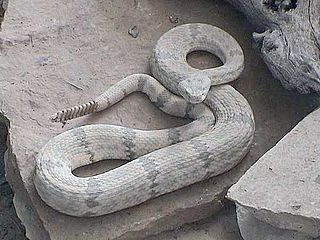
Crotalus lepidus is a venomous pit viper species found in the southwestern United States and northern central Mexico. Four subspecies are currently recognized, including the nominate subspecies described here.

The western diamondback rattlesnake or Texas diamond-back is a rattlesnake species and member of the viper family, found in the southwestern United States and Mexico. Like all other rattlesnakes and all other vipers, it is venomous. It is likely responsible for the majority of snakebite fatalities in northern Mexico and the greatest number of snakebites in the U.S. No subspecies are currently recognized.

Crotalus viridis is a venomous pit viper species native to the western United States, southwestern Canada, and northern Mexico. Currently, two subspecies are recognized, including the prairie rattlesnake, the nominate subspecies, and the Hopi rattlesnake.

The Texas garter snake is a subspecies of the common garter snake. The subspecies, which belongs to the subfamily Natricinae of the family Colubridae, is native to the western United States.

Rhinocheilus lecontei tessellatus is a subspecies of nonvenomous colubrid snake, which is native to the western United States and northern Mexico.

Drymobius margaritiferus, commonly known as the speckled racer, is a species of nonvenomous colubrid snake native to the Americas. The specific name, margaritiferus, means "pearl-bearing" in Latin, referring to the pearl-like spots on the dorsal scales.
The unicolor cribo is a Central American subspecies of the cribo snakes. The eastern indigo snake, Drymarchon corais couperi is another species of this genus. Until recently the unicolor cribo was considered a subspecies of the same species as the indigo snake Drymarchon corais unicolor.
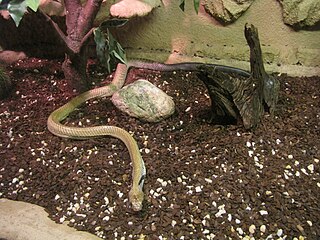
The Middle American indigo snake, also known commonly as the blacktail cribo, is a species of large, nonvenomous, snake in the family Colubridae. The species is native to the southwestern United States, Mexico, Central America, and northern South America. In addition to the nominate subspecies, it has four other recognized subspecies, including D. m. erebennus, commonly known as the Texas indigo snake.

The bullsnake is a large, nonvenomous, colubrid snake. It is a subspecies of the gopher snake. The bullsnake is one of the largest/longest snakes of North America and the United States, reaching lengths up to 8 ft.
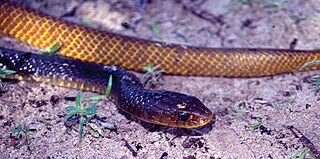
The indigo snake is a species of snake of the family Colubridae. This large colubrid snake is nonvenomous.
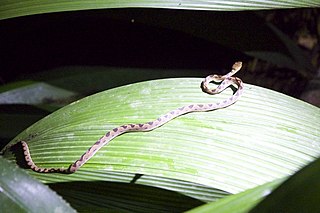
Leptodeira septentrionalis, the northern cat-eyed snake, is a species of medium-sized, slightly venomous snake, found from southern Texas to Costa Rica.



















